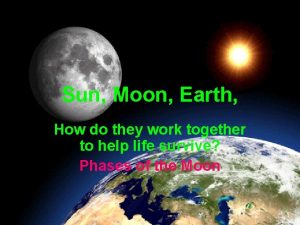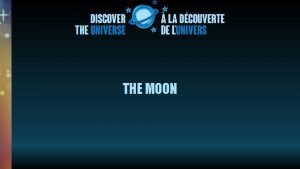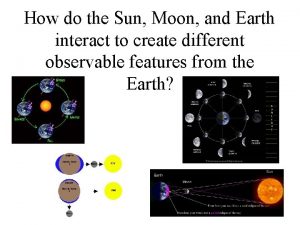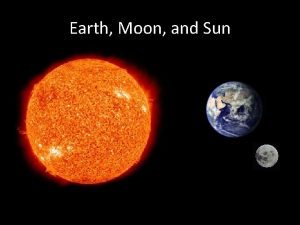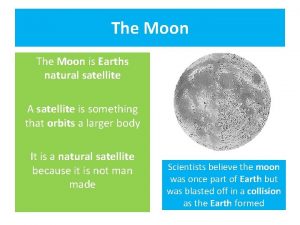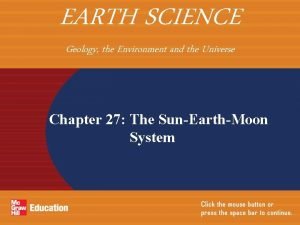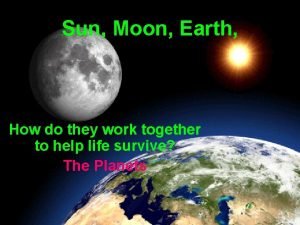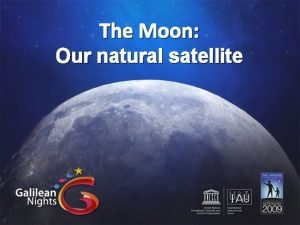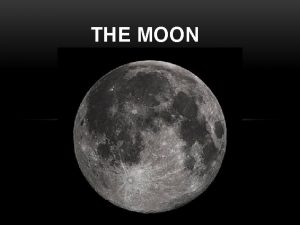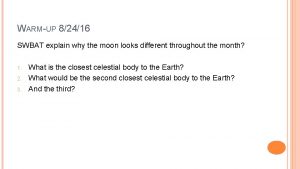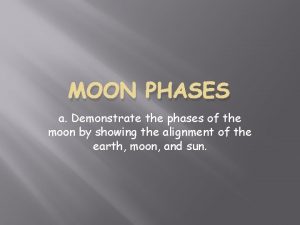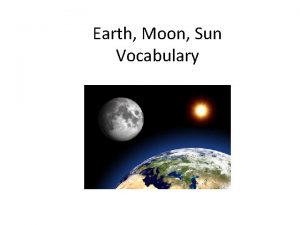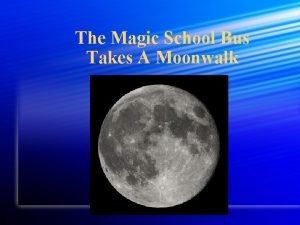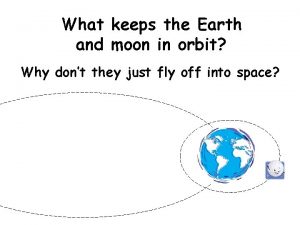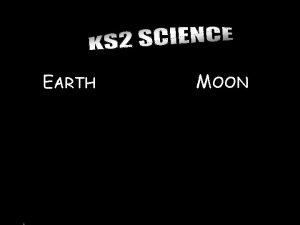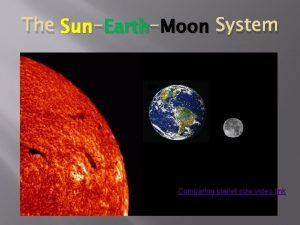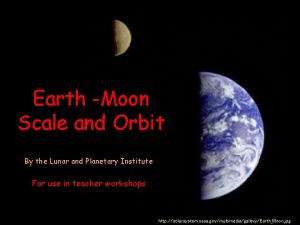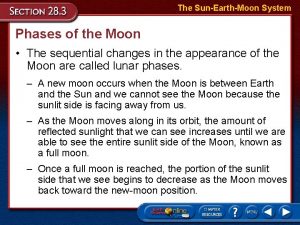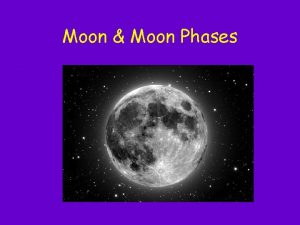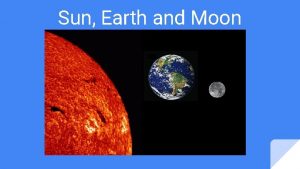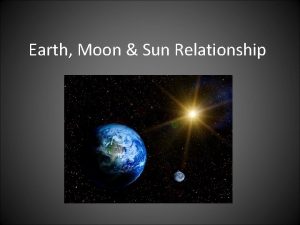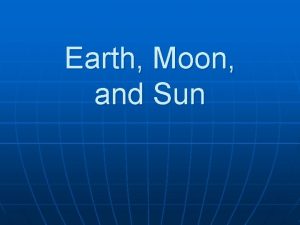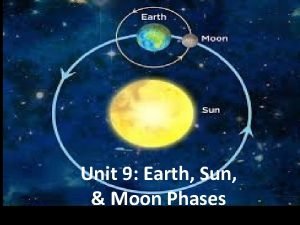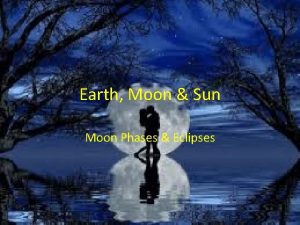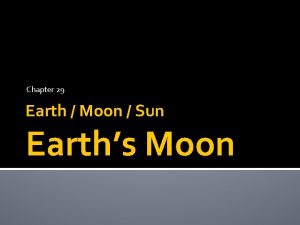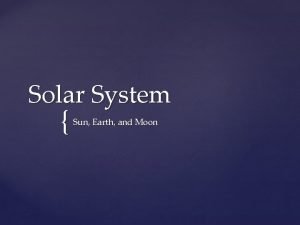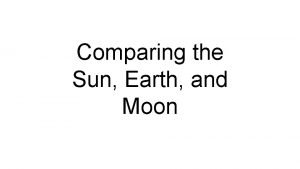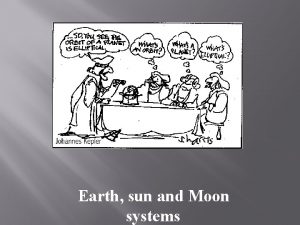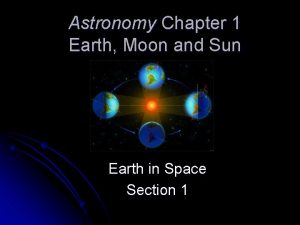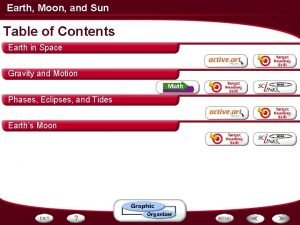Sun Moon Earth How do they work together






























- Slides: 30

Sun, Moon, Earth, How do they work together to help life survive? Seasons

Myth or fact: • Seasons are caused by the distance from the Earth to the sun.

Seasons Misconception • Seasons are caused by the distance from the Earth to the sun. – Myth: The Earth’s orbit around the Sun is nearly a perfect circle. The Earth is slightly closer to the Sun in January and farther from the Sun in July.

Seasons Misconception • Seasons are caused by the distance from the Earth to the sun. – The Earth’s orbit around the Sun is nearly a perfect circle. The Earth is slightly closer to the Sun in January and farther from the Sun in July. • Perihelion (closest to the Sun) is around January 3 when Earth is about 91, 405, 436 miles from the Sun.

Seasons Misconception • Seasons are caused by the distance from the Earth to the sun. – The Earth’s orbit is nearly a perfect circle. The Earth is slightly closer to the Sun in January and farther from the Sun in July. • Perihelion (closest to the Sun) is around January 3 when Earth is about 91, 405, 436 miles from the Sun. • Aphelion (farthest from the Sun) is around July 4 when Earth is about 94, 511, 989 miles from the Sun.

Orbit of the Earth

The Constellations on the Ecliptic • As the Earth revolves about the Sun, the Sun “appears” to move through a set of 12 constellations (the zodiac).

The Constellations on the Ecliptic • As the Earth revolves about the Sun, the Sun “appears” to move through a set of 12 constellations (the zodiac). • The apparent path of the Sun through the sky is called the ecliptic.


Seasons • The seasons are due to the tilt of the Earth’s axis.

Equinoxes and Solstices • The Vernal (Spring) Equinox (about March 21): Sun’s direct rays over the equator.

Vernal Equinox – The Sun will appear directly overhead to someone on the equator at 0 degrees latitude.

Vernal Equinox – The Sun will appear directly overhead to someone on the equator at 0 degrees latitude. – The Sun rises at the North Pole, ending 6 months of longer nights and beginning 6 months of longer days.

Vernal Equinox – The Sun will appear directly overhead to someone on the equator at 0 degrees latitude. – The Sun rises at the North Pole, ending 6 months of longer nights and beginning 6 months of longer days. – The Sun sets at the South Pole ending 6 months of longer days and beginning 6 months of longer night.

Equinoxes and Solstices • The Summer Solstice (about June 21): The location where the Sun is at its furthest north.

Summer Solstice –The Sun will appear directly overhead to someone at 23. 5 degrees north latitude. This latitude is called the Tropic of Cancer.

Tropics

Earth on June 21

Summer Solstice –The Sun will appear directly overhead to someone at 23. 5 degrees north latitude. This latitude is called the Tropic of Cancer. –Summer in the N. Hemisphere and winter in the S. Hemisphere

Equinoxes and Solstices • The Autumnal (Fall) Equinox (about September 21): Sun’s direct rays over the equator.

Autumnal Equinox – The Sun will appear directly overhead to someone on the equator at 0 degrees latitude. Equal day/night

Autumnal Equinox – The Sun will appear directly overhead to someone on the equator at 0 degrees latitude. Equal day/night – The Sun sets at the North Pole, ending 6 months of longer days and beginning 6 months of longer nights.

Autumnal Equinox – The Sun will appear directly overhead to someone on the equator at 0 degrees latitude. Equal day/night – The Sun sets at the North Pole, ending 6 months of longer days and beginning 6 months of longer nights. – The Sun rises at the South Pole ending 6 months of longer nights and beginning 6 months of longer days.

Equinoxes and Solstices • The Winter Solstice (about December 21): The location where the Sun is at its furthest south.

Winter Solstice –The Sun will appear directly overhead to someone at 23. 5 degrees south latitude, the Tropic of Capricorn.

Winter Solstice –The Sun will appear directly overhead to someone at 23. 5 degrees south latitude, the Tropic of Capricorn. –Summer in the S. Hemisphere and winter in the N. Hemisphere

Earth on December 21

Seasons Misconception –(While it is winter in the Northern hemisphere it is summer in the Southern hemisphere. If the seasons were due to our distance from the Sun both hemispheres would have the same seasons at the same time. )


 How do the sun and moon work together
How do the sun and moon work together How does the sun moon and earth work together
How does the sun moon and earth work together Does moon rotate
Does moon rotate The sun-earth-moon system worksheet answers lesson 1
The sun-earth-moon system worksheet answers lesson 1 What season is this
What season is this Earth sun moon relationship
Earth sun moon relationship Earth vs sun
Earth vs sun Whats a natural satellite
Whats a natural satellite Earth moon
Earth moon How the sun and moon work
How the sun and moon work The science duo
The science duo Which moon phase occurs directly before a new moon
Which moon phase occurs directly before a new moon Moon sister moon calendar
Moon sister moon calendar Home.hiwaay.net/ krcool/astro/moon/moon tides/
Home.hiwaay.net/ krcool/astro/moon/moon tides/ Moons pattern
Moons pattern Moon phases when the sun is on the left
Moon phases when the sun is on the left Totally tessellated
Totally tessellated Moon phases when the sun is on the left
Moon phases when the sun is on the left Moon
Moon Sun moon lake marathon
Sun moon lake marathon Moon and sun comparison
Moon and sun comparison Dangdang ay history
Dangdang ay history 1 yojan in jainism
1 yojan in jainism Personification examples for rain
Personification examples for rain Magic school bus takes a moonwalk
Magic school bus takes a moonwalk Moonfall msv
Moonfall msv 22.3 earth's moon
22.3 earth's moon How big is the moon compared to the earth
How big is the moon compared to the earth Size of moon compared to earth
Size of moon compared to earth Earth moon scale
Earth moon scale Earth moon
Earth moon

